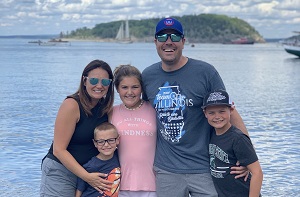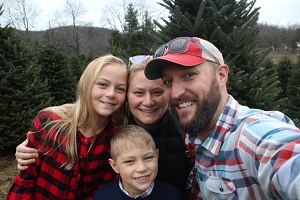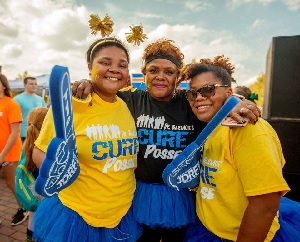Quarantine Life: How Some T1D Families Are Coping

Quarantine life—stressful for everyone for numerous reasons—is putting the squeeze on families across the country.
Many parents who are fortunate enough to have kept their jobs, and who can work from home, are pulling double duty as they try to teach their kids and work at the same time.
Below, how a few JDRF families have been managing these challenges during the pandemic—as well as the ever-present challenge of life with type 1 diabetes (T1D)—and their messages of hope for the T1D community.
“The management of T1D is just one other stress we are managing during these difficult times.”
 Matt Carletti, Board Member, JDRF Illinois Chapter
Matt Carletti, Board Member, JDRF Illinois Chapter
Family of five with three children, one of whom has T1D
“Each night, our second grade son’s teacher emails out the next day’s assignments. This includes links to any documents that need to be printed out and videos that he will need to watch as part of his work. Each night, we print out all of the materials that he needs for the next morning so that when the day begins, he is ready and organized to start his eLearning.“
“He also has a daily class Zoom meeting each morning that we keep on our phone calendars. He also sets an alarm for himself each day 10 minutes before the Zoom so that he knows when to sign onto the call. By being organized with his eLearning materials, we are also able to seamlessly manage his T1D throughout the day as we juggle our own work loads and the eLearning of his two siblings in 5th and 7th grade.”
“Because our son was also working on managing his T1D independently at school with the school nurse, we also are working on those same processes at home, including making sure our T1D self-advocates for himself when he feels low and testing himself when necessary. And, of course, we try to make sure that he gets some time outdoors during the day to remain healthy and active.”
“The management of T1D is just one other stress we are managing during these difficult times.”
“Life with T1D has given us the skills to be prepared for any situation.”
 Jen Seeba, Winston-Salem Outreach Captain, JDRF Piedmont Triad Chapter (North Carolina)
Jen Seeba, Winston-Salem Outreach Captain, JDRF Piedmont Triad Chapter (North Carolina)
Family of four with two children, one of whom has T1D
“When our kitchen remodel started in March, we were anxious to be in a condensed living space with a makeshift kitchen for 4 months. I love to cook. Healthy at-home meals are a priority for us, in part because our daughter has T1D and celiac disease.”
“Then COVID-19 exploded and things got a little hairy. While our construction* is contained to a sectioned-off area of the house, we are now stuck with 2 adults and 2 elementary-aged children trying to work and learn at home in a makeshift living space with A LOT of extra noise.”
“We keep a regular schedule during the week. My husband and I wake up early to get a couple of hours of work in before the kids wake up. We take scheduled, alternating time to help the kids with schoolwork during the day. We wear headphones. We try to eat lunch together.”
“The kids are in charge of completing their daily task list outside of school-related work–chores, practicing piano/violin, outside time, creative time. My daughter has a late-day class meeting online, so we’ve put a reminder in her phone, so she is responsible for remembering and logging in. I make sure we have healthy snacks (fruit, cut-up veggies, nuts) easily available and emphasize active outside time for the kids in the afternoon. At the end of the day, weather permitting, we go on a family walk.”
“In reality, things are not perfect. We are stressed, we are snacking more, things don’t always go as planned, and we miss our community. We’ve struggled with blood sugar control. As with everything, we take a deep breath, give ourselves grace, and adjust!”
“Life with T1D has given us the skills to be prepared for any situation and the resilience to cope with the highs and lows thrown our way. Even though we are apart, together, we can get through this.”
*Note: this anecdote collected before many states deemed construction non-essential work.
“We have a lot more reserve than we realize.”
 Dr. LaShelle Barmore, Outreach Volunteer and Advocate, JDRF Gulf States Chapter (Alabama, Louisiana and Mississippi)
Dr. LaShelle Barmore, Outreach Volunteer and Advocate, JDRF Gulf States Chapter (Alabama, Louisiana and Mississippi)
Family of four with two children—but Dr. Barmore is the family member who has T1D
“I did about 6 weeks when I actually was working from home doing telemedicine visits. There at the beginning, I probably wasn’t managing it all very well. We turned in assignments late, there were a lot of things that didn’t get attached or submitted like they were supposed to.”
“Honestly speaking I felt probably more overwhelmed with trying to figure out what work-life balance was under those circumstances. You feel very obligated to provide your children with the appropriate education while trying to give your patients your undivided attention.”
“One of the biggest challenges for me was that as a result of trying to have more food on hand that my kids could conveniently fix for themselves, I wasn’t always doing great at following a low carb diet. I do use an insulin pump system. Fortunately, it kind of helps to make up for my errors, but a lot of times I felt the slug of eating too many carbs.”
“Just the pressure of trying to be the mom that does it all was very overwhelming, but I realized that it was similar to when someone is first diagnosed with T1D—that’s also a ridiculously overwhelming situation. And I think that we [people who live with T1D] have a lot more reserve than we realize. We know how to organize things, we know how to create a schedule, how to make it work, and that’s what I’ve had to lean on. When the schedule is off, I have to be able to adapt and at the end of the day, it may not be perfect, but it works. That’s the most important piece.”
“My son loves John Cena. His bedroom is right next to my home office. And when I was doing the video conferences with my patients, he would play John Cena’s theme music as loudly as possible on his Alexa. And I think that this whole event has made us all realize that regardless of what you do, everybody’s human. As much as my patients see me as their doctor—their professional healthcare provider—my first job is to be a mom. And my patients saw the reality of that.”
“Look for the helpers.”
Erin O’Donnell Dotzler, Board Member, JDRF Illinois Chapter
Family of five including three children, one of whom has T1D
“Fred Rodgers always said, ‘Look for the helpers.’ This mantra has been something we’ve espoused over the last 4+ years given our more intimate interface with the numerous healthcare professionals, nurses and doctors associated with our 8 year-old son’s T1D journey.”
“It brings comfort and hope during times of challenge and fear. The circumstances with COVID-19 has prompted us to repeat this more frequently, with more intimate recognition of the numerous healthcare professionals, scientists and experts who are passionately and determinedly working to keep us safe, and treat sick people.”
“Our family finds great comfort in focusing on the helpers, and celebrating the expertise, resources, access, knowledge and opportunity that now exists because of advancing science and knowledge.”
“Those associated with finding a cure for T1D and the mission of JDRF have been ‘part of the solution’ and are part of the bigger community of scientists, researchers and healthcare providers, who are doggedly focused on cures and bringing people back to health.”